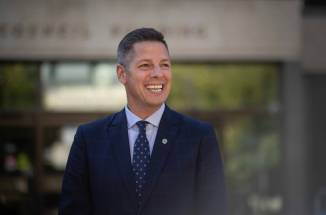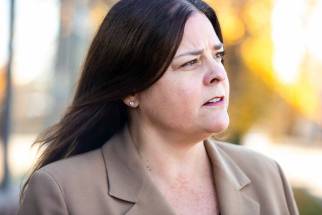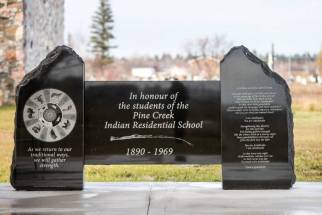Transparency is key to residential school searches
Read this article for free:
or
Already have an account? Log in here »
To continue reading, please subscribe:
Monthly Digital Subscription
$0 for the first 4 weeks*
- Enjoy unlimited reading on winnipegfreepress.com
- Read the E-Edition, our digital replica newspaper
- Access News Break, our award-winning app
- Play interactive puzzles
*No charge for 4 weeks then price increases to the regular rate of $19.00 plus GST every four weeks. Offer available to new and qualified returning subscribers only. Cancel any time.
Monthly Digital Subscription
$4.75/week*
- Enjoy unlimited reading on winnipegfreepress.com
- Read the E-Edition, our digital replica newspaper
- Access News Break, our award-winning app
- Play interactive puzzles
*Billed as $19 plus GST every four weeks. Cancel any time.
To continue reading, please subscribe:
Add Free Press access to your Brandon Sun subscription for only an additional
$1 for the first 4 weeks*
*Your next subscription payment will increase by $1.00 and you will be charged $16.99 plus GST for four weeks. After four weeks, your payment will increase to $23.99 plus GST every four weeks.
Read unlimited articles for free today:
or
Already have an account? Log in here »
Hey there, time traveller!
This article was published 19/10/2022 (1144 days ago), so information in it may no longer be current.
A unprecedented strategy to investigate potential unmarked graves is a welcome attempt to bring clarity to past treatment of students at a Manitoba residential school. What could also bring clarity to the same issue is a more committed effort by government and the Roman Catholic church to publicly release residential school documents.
Minegoziibe Anishinabe, also known as Pine Creek First Nation, announced last week it will work with RCMP in a collaborative joint examination that is described by Chief Derek Nepinak as the first of its kind. The RCMP were called in at the request of the First Nation after survivors reported criminal abuses they endured at the residential school.
At the centre of the issue are soil anomalies, some about 1.25 metres long, that were detected by ground-penetrating radar at the site of the Pine Creek Residential School. Similar anomalies have been detected at former residential schools in other parts of Canada, leading to speculation of unmarked graves. To date, none has been excavated.
ADRIAN WYLD / THE CANADIAN PRESS FILES Pine Creek First Nation Chief Derek Nepinak.
To be clear, it’s not as if Pine Creek has shovels and is beginning to dig. The First Nation is proceeding with respectful caution, fully aware that past calls to exhume potential graves at residential school sites have prompted controversy. While some people say unearthing graves would help honour residential school victims by providing an accurate record of their demise, others insist the dead should not be disturbed.
Pine Creek and the Mounties say the first phase of the investigation will include using a trauma-based approach to speak with witnesses such as elders who remember accounts of abuse at the school that operated from 1890 to 1969. If they gather credible evidence of crimes having been committed, police say they will consider examining the soil anomalies.
“It is our hope that in establishing a true and clear history of what we have survived as Anishinabeg people, our ancestors and residential school survivors will forever be remembered for their strength and courage, while giving our future generations an opportunity to know the truth about who we are and what we have survived,” said Chief Nepinak.
“It is our hope that in establishing a true and clear history of what we have survived as Anishinabeg people, our ancestors and residential school survivors will forever be remembered for their strength and courage.”–Chief Derek Nepinak
While the initiative at Pine Creek seeks reliable information about residential school students, the same goal is being pursued simultaneously in a different way. Several lobbying efforts have continued to pressure Ottawa and the Catholic church to publicly release a trove of documents related to the schools.
The National Centre for Truth and Reconciliation at the University of Manitoba has archived more than five million documents and 6,000 witness statements, but many more documents are still held elsewhere, even though the government and churches have previously pledged to co-operate with requests for records.
The latest group to seek full public release of the remaining residential school documents is the Canadian Federation of Library Associations, which on Sept. 29 called on the federal government to turn over 12,ooo outstanding documents. The group said releasing the records is essential for the “achievement of justice” and to understand the human-rights abuses committed at residential schools.
MIKAELA MACKENZIE / WINNIPEG FREE PRESS FILES The Pine Creek Residential School memorial.
At the same time, researchers at the University of Ottawa say some archival evidence related to 48 residential schools once run by the Oblates of Mary Immaculate are now available only in Rome and, so far, the Vatican has stymied calls to release the papers.
The investigation of suspected graves at Pine Creek and the ongoing pressure for full disclosure from both government and church are united in a single purpose: to learn the truth. That’s “truth,” as in Truth and Reconciliation. It’s the least that can be done for survivors, and for the families of students who didn’t survive.








